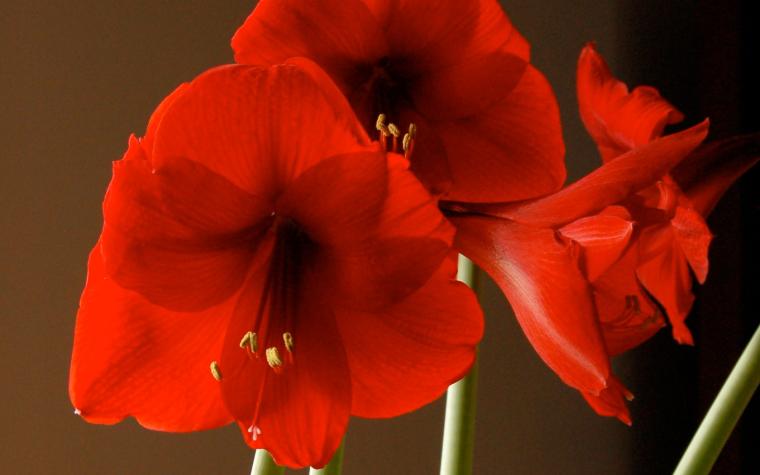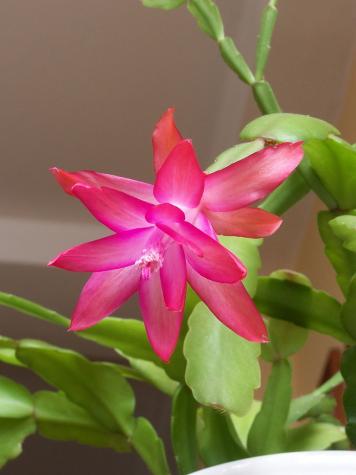Source: David Trinklein, 573-882-9631
COLUMBIA, Mo. – Holiday plants can live to bloom another year with proper care, said University of Missouri Extension state horticulturist David Trinklein. Now is the time to start that care.
Plants such as amaryllis and Christmas cactus received as gifts this past Christmas are fairly easy to rebloom next holiday season. They truly are “gifts that keeps on giving,” said Trinklein.
Amaryllis production is relatively straightforward
If you received a flowering amaryllis, keep the growing medium uniformly moist. After the last flower fades, cut off the flowering stalks and put the plant in a bright area. Fertilize with a houseplant fertilizer according to label directions and allow leaves to grow.
If you got a bulb instead of a flowering plant, amaryllis production for the hobbyist is relatively straightforward, said Trinklein. Plant the bulb in a well-drained, highly organic potting mix that retains adequate moisture. “Peat-lite” mixes containing peat moss, vermiculite and perlite work well. If the bulb did not come with a pot, choose one that is 2 or more inches wider than the bulb’s diameter.
Amaryllis is a tropical plant and responds well to a warm environment—at least 70 degrees Fahrenheit during the day and 60 degrees at night. Avoid temperatures lower than 50 degrees. Amaryllis needs about six to eight weeks from the beginning of new bulb growth to flower.
Reblooming amaryllis is relatively easy, but the plant needs to make and store food in its bulb first. Expose the plant to bright light during the growth period after flowering ends. Water and fertilize according to label directions.
After the danger of frost passes, move the plant outdoors to a lightly shaded area. Bring the plant inside in September. Keep the bulb in a cool area and withhold water to induce dormancy. Remove withered leaves and maintain dormancy for several months.
Force the bulb out of dormancy into flowering by watering and putting it in a warm, bright area. Repot if the bulb outgrows its original container.
Holiday cacti benefit from bright light, proper watering
Many plants sold as Christmas cacti today are a combination of Christmas cactus and Thanksgiving cactus. A more appropriate name might be holiday cactus, said Trinklein.
Holiday cacti tolerate low light but perform best in bright, indirect light in the home, especially during winter. However, if you move plants outside during summer, keep them in a semi-shady location. Full sun during the summer can result in pale plants. Ideal temperature is 70-80 degrees for its season of active growth, April to September.
Holiday cacti are native to a small coastal region of Brazil. As tropical plants, they are not quite as drought-resistant as their name might imply. Like most cacti, however, they do not like a wet root environment. Water only when the growing medium is dry to the touch. A soggy growing medium encourages root rot. Empty drainage saucers to keep excess water from wicking back in the pot.
Only fertilize plants from early spring through late summer. Apply a regular fertilizer at one-quarter strength or a houseplant fertilizer according to label directions.
Keep holiday cacti slightly pot-bound for prolific flowering. Repot about every three years. Use a porous and well-drained medium. Choose commercial peat-lite mixes made for epiphytes, or add more perlite or sterile sharp sand to regular peat-lite mixes to increase porosity.
Holiday cacti need short days, cool nights and dry conditions in October
“Reblooming holiday cacti is not that difficult,” said Trinklein. These short-day plants flower in response to both day length and temperature. Most prolific flowering occurs when plants experience short days with at least 13 hours of darkness and cool nighttime conditions. Limit watering to slightly stress the plant, which aids in flower induction. “In short, subjecting holiday cacti to short days, cool nights and dry conditions in October will cause plants to be in full bloom for the holiday season,” Trinklein said.
Photos
Amaryllis
Amaryllis. Photo by Chris Starbuck.
Holiday cactus
Schlumbergera truncata, a type of holiday cactus. Photo by Jan Mehlich. Shared under a Creative Commons License (CC BY-SA 2.5).

